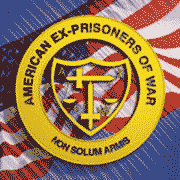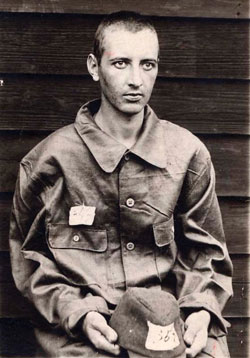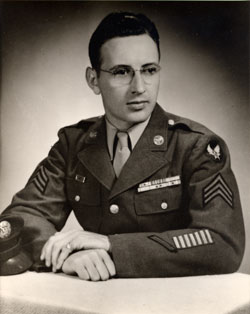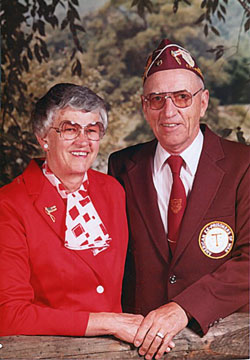
Established April 14, 1942
 |
American Ex-Prisoners of War
A not-for-profit, Congressionally-chartered veterans’ service organization advocating for former prisoners of war and their families.
Established April 14, 1942 |


Cecil Cunningham in POW camp
|

Sergeant Cecil Cunningham
|

Cecil and Ruth Cunningham, 1984, at AXPOW National Convention, Tacoma, WA.
|
| Last Name | First Name, Middle Init. | Nickname |
| Spouse | City | State, Zip |
| Conflict — Theatre | Branch of Service | Unit: |
| Military Job | Date Captured | Where Captured |
| Age at Capture | Time Interned | Camps |
| Date Liberated | Medals Received | |
| After the War ... | ||
On October 10, 1940 at the age of 22, Cecil enlisted in the Army Air Corps and was sent to March Field in California for Boot Camp. He was assigned to the 7th Material Squadron--Motor Pool Division--as a private and earned $21.00 a month. Cecil was transferred to Albuquerque, New Mexico with the 19th Bomb Group. He was assigned to drive staff car for the Commanding Officer. On two different occasions, he drove for the Commanding General of the U. S. Army Air Corps. In September, 1941 Cecil’s outfit received orders to ship out. The Commanding Officer asked Cecil to stay behind as his driver, but he wanted to go with his unit. This became a life-altering decision.
On September 28, Cecil boarded the Holbrook, arrived in the Philippines on October 15 and was sent to Clark Field. After being there only a short time, Cecil became attached to the 5th Air Base. He was assigned to a special Motor Pool detail of 20 men and 10 trucks from the 7th Material Squadron and shipped to Malaybalay, Mindanao to help build the Del Monte Air Base. Cecil arrived one day before the war broke out. The rest of his squadron remained at Clark Field and later suffered the Bataan Death March. Cecil worked at the Del Monte Air Base refueling planes. His main job was to load 55-gallon drums of gasoline onto trucks and haul them to the base. He helped fuel General McArthur’s plane before his escape to Australia.
Word reached Cecil that Bataan had fallen into the hands of the Japanese on April 9, 1942. On May 10, the Armed Forces were told to surrender to the Japanese. Cecil was held at Malaybalay until September, 1942 when the Japanese moved him by boat to Davao Penal Colony in southern Mindanao. While at Davao, he worked in a machine shop, in transportation and worked 10 to 12 hours a day as a slave laborer in the rice fields. He suffered frequent attacks of malaria due to the lack of quinine. Beriberi and other problems related to malnutrition were health problems that plagued him.
On June 4, 1944, his group was loaded onto trucks, made to stand, then blindfolded and roped together for a 4-hour trip to Davao Harbor. He was then loaded onto the crowded Hellship, Canadian Inventor, otherwise known as the Monti Monti Maru where only one out of three prisoners could lie down at one time. Cecil arrived in Manila in late June. After spending a week in Bilibid Prison, he was reloaded back onto the Monti Monti Maru. Due to delays caused by boiler problems and a typhoon, he arrived in Japan on September 1st. This 90-day trip was on record as one of the longest Hellship “cruises” to Japan.
Cecil was sent to Yokkaichi Prison Camp to work as a slave laborer in a copper foundry, loading ore carts and pushing them to the smelter. There was a huge earthquake and a big smoke stack fell where he had been working only a few minutes before. As Cecil was walking back to camp, the earth opened up right beside his left foot revealing water, then the earth quickly closed again.
His last six months of internment he spent in sick bay, paralyzed in his right leg and arm from beriberi and malnutrition.
After the two atomic bombs were dropped on Japan in August of 1945, the war was over. The British were the first to find his POW camp, dropping food and supplies to the men. One prisoner ran out to be the first to get the food. He was killed by a 55-gallon drum containing lifesaving supplies.
Cecil was liberated on September 9, 1945 after spending a total of 1,212 days or almost 3 ½ years as a prisoner-of-war. His weight had dropped from 185 pounds to 89 pounds during his ordeal.
Cecil was sent aboard the hospital ship, U.S.S. Rescue at Tokyo Bay on September 12, 1945. He was deloused and given all new clothing. On September 14, he was transferred to the U.S.S. Benevolence, deloused again and given pajamas. All the new clothes were pushed overboard to prevent the spread of lice. He arrived in San Francisco on October 8. After spending a week in Letterman General Hospital, Cecil was sent to Fitzsimons General Hospital in Denver, Colorado for two months.
He was discharged from the Army Air Corps as a Sergeant on April 19, 1946 after serving his country for 5 1/2 years.
After his discharge, Cecil worked for Sandifur Brothers transporting Willy jeeps and trucks from Toledo, Ohio to Spokane. He then worked as a bus driver for Auto Interurban. In 1950, Cecil went to work for Consolidated Freightways as a transport operator. He retired in 1979.
Exactly one year to the day after his discharge from the service, Cecil married Ruth G. Sinrud on April 19, 1947. He was first introduced to Ruth in 1936 when his sister married her brother. They raised two daughters, Susan and Gloria. Cecil has four grandchildren and seven great-grandchildren. Cecil and Ruth were married 55 years.
Cecil and his wife spent many years helping organize the Inland Empire Chapter of American Ex-Prisoners of War, getting other POWs to come forward and share their own stories. Ruth served over 30 years as adjutant for the chapter. In 2001, Ruth was selected as Outstanding Female Non-Veteran for services to veterans in Washington State.